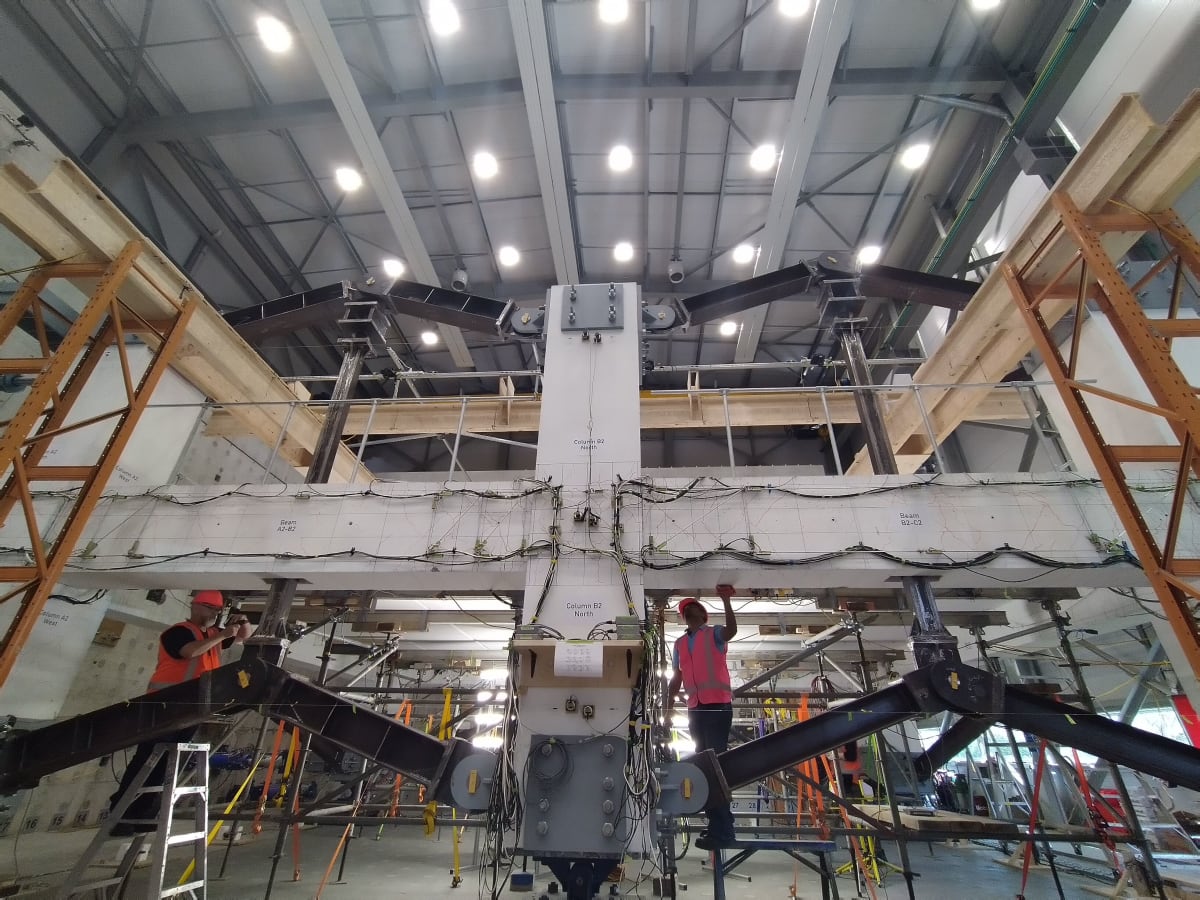In order to test what happens to buildings in an earthquake, a life-size replica of one floor of a 10-storey building was built at the University of Canterbury. The walls of the building are pushed and pulled with violent force to replicate our most damaging quakes. The whole structure sits on an expensive isolating base so the rest of the university doesn’t shake to bits.
It’s important research because concrete buildings represent the majority of existing commercial buildings in New Zealand cities, and most are built using precast floors. As it turns out, that method of construction means a lot of potential risk in a big earthquake.
“The Canterbury earthquakes 10 years ago changed the way we looked at buildings in New Zealand,” said Dr Brendon Bradley, Director of QuakeCoRE and Professor in Earthquake Engineering at the University of Canterbury.
“Before then, because it had been such a long time since an earthquake really struck at the heart of an urban area, we had almost forgotten what it was like to experience such loss of life and property. It really galvanised research funding for earthquake engineering to improve New Zealand’s buildings,” said Bradley.
But has the research helped us build safer cities? Not yet, according to Bradley.
“I would say we have made progress but nowhere near fast enough. If we had a big earthquake tomorrow, we would suffer similar damage. I think there will be the same consequences if we have one in the next decade.
“There is probably a public expectation that [the same amount of damage] won’t happen but we are a long way from where society expects us to be.”
After the 2016 Kaikōura earthquake, collapsed precast floor units in Wellington’s Statistics House and damaged units in approximately another 35 buildings in the city, it became obvious that many of our buildings have an earthquake resilience problem.
The fact each building reacts differently in an earthquake makes the issue more complex ,according to Bradley.
“We can identify buildings are of a certain type but we can’t say for certain if they will collapse. Every building has a different design, different engineering and building companies use slightly different construction methods.
“It is not the same as cars coming out of a factory where you would expect them to be identical. Buildings are much more complex and while some are not very earthquake resistant and will collapse, not all will.
“The cost to change every building would be much more than we are spending in the current Covid crisis but what we should be doing is spending more money on new buildings.”
The short-term thinking of politicians added to the problem, said Bradley
“The political landscape is not aligned to long-term planning. We want to build things at the minimum price. The way we look at infrastructure should be different, it is the backbone of society.
“Take hospitals, we want them to last for 50 years, so we should spend a little bit more to make them very earthquake resistant, very efficient at retaining heat and they should have solar panels on the roof, but generally as a society we are making everything on the cheap.”
The work being done at the University of Canterbury is funded by BRANZ, EQC, the Concrete Society, the University of Canterbury, the University of Auckland and QuakeCoRE.

QuakeCoRE is a Centre of Research Excellence funded by the Tertiary Education Commission. CoREs are inter-institutional research networks, with teams working together on commonly agreed work programmes.
“QuakeCoRE is involved in cutting-edge research aimed at saving lives in buildings with pre-cast concrete floors in an earthquake. Key to the project is finding economical and easy-to-install retrofits,” said Dr Ken Elwood, QuakeCoRE Research Director, Professor of Civil Engineering at the University of Auckland and the research project leader.
“The damage observed after this pushing and pulling was very similar to many buildings in Wellington. Now we are pushing it further to see how the retrofits will perform in a much bigger earthquake, for which we all know Wellington is long overdue.”
“This project is looking at two retrofit solutions for precast concrete floors. We’re currently testing steel supports and then we will look at cable catch systems. Both systems are thought to be cost effective, easy to install, and conducive to saving lives in future earthquakes,” said Elwood.
“Because industry is a direct partner in the research programme, the new retrofit practices are being immediately implemented; they really need the answers we are seeking yesterday”
The University of Canterbury’s Bradley wants a lot more money put into earthquake research.
“We spent $40 billion fixing the damage from the Canterbury earthquakes. If we look at what companies spend on research and development, the average is about 1 percent [of their turnover] so we should be spending about $400 million instead of the current $40 million. We are underspending by a factor of 10,”said Bradley.



